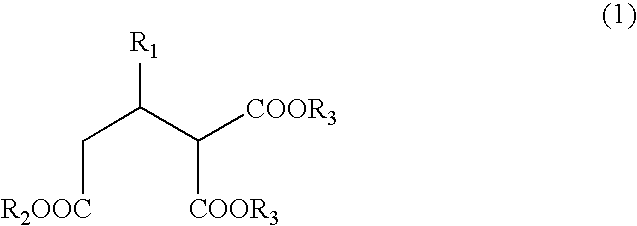Process for producing optically active 2-alkyl-1,1,3-trialkoxycarbonylpropane
- Summary
- Abstract
- Description
- Claims
- Application Information
AI Technical Summary
Benefits of technology
Problems solved by technology
Method used
Image
Examples
examples
[0055]In the following, the present invention will be explained more specifically by way of examples; however, the present invention is not limited to these examples.
examples 1 to 14
[0056]To 35 mg of 2-methyl-1,1,3-trimethoxycarbonylpropane and each of various enzymes shown in Table 1 respectively weighed in the amount shown in Table 2, 2 mL of 100 mM potassium phosphate buffer (pH 7.0) was added. The resultant solution was stirred at 25° C. for 20 hours, and then 2.5 mL of acetonitrile was added thereto and the mixture was drawn through a membrane filter. The optical purity of the resultant filtrate was analyzed by high performance liquid chromatography [column: CHIRALCEL (registered trademark) OB-H, 4.6 mmφ×15 cm, 5μm (produced by Daicel Chemical Industries, Ltd.)], and the chemical purity was analyzed by high performance liquid chromatography [column: SUMIPAX ODS D-210FF, 4.6 mmφ×15 cm, 3 μm (available from Sumika Chemical Analysis Service, Ltd.)]; and thus, yield and enantiomer excess of the obtained optically active 2-methyl-1,1,3-trimethoxycarbonylpropane were determined. The results are shown in Table 2.
examples 15 , 16
Examples 15, 16
[0057]To 70 mg of 2-methyl-1,1,3-trimethoxycarbonylpropane and an enzyme shown in Table 1 weighed in the amount shown in Table 2, 4 mL of 100 mM potassium phosphate buffer (pH 7.0) was added. The resultant solution was stirred at 25° C. for 3.5 hours, and then 5 mL of acetonitrile was added thereto and the mixture was drawn through a membrane filter. The filtrate was analyzed in the same method as in Examples 1 to 14, and yield and enantiomer excess of obtained optically active 2-methyl-1,1,3-trimethoxycarbonylpropane were determined. The results are shown in Table 2.
TABLE 1EnzymemanufacturerPreparation(commerciallymethod ofExampleName of enzymeOrigin of enzymeavailable enzyme)enzyme1CholesterolCandidaRoche DiagnosticsEsterasecylindracea2CHIRAZYME E-3, lyoThermophilicRoche Diagnosticsmicro-organism3Cholesterol esterase, lyoCandidaRoche Diagnostics4PLE-APig liverAmano Enzyme5ChiroCLEC-CRCandida rugosaAltus Biologics6CHIRAZYME L-3Candida rugosaRoche Diagnostics7Lipase O...
PUM
 Login to View More
Login to View More Abstract
Description
Claims
Application Information
 Login to View More
Login to View More - R&D Engineer
- R&D Manager
- IP Professional
- Industry Leading Data Capabilities
- Powerful AI technology
- Patent DNA Extraction
Browse by: Latest US Patents, China's latest patents, Technical Efficacy Thesaurus, Application Domain, Technology Topic, Popular Technical Reports.
© 2024 PatSnap. All rights reserved.Legal|Privacy policy|Modern Slavery Act Transparency Statement|Sitemap|About US| Contact US: help@patsnap.com










